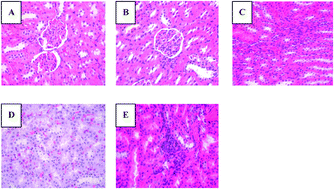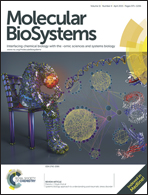A urinary metabolomics study of rats after the exposure to acrylamide by ultra performance liquid chromatography coupled with quadrupole time-of-flight tandem mass spectrometry†
Abstract
Acrylamide (ACR) is known to induce neurotoxicity in humans and occupational exposure to ACR has an effect on human health. Since some animal experiments indicate the metabolic change caused by the ACR based on the metabolomics, increasing concern is the change of metabolite profiles by the low-dose ACR. In the present study, a low-dose of ACR (18 mg kg−1) was administered to male Wistar rats for 40 days. Ultra performance liquid chromatography/time of flight mass spectrometry (UPLC-Q-TOF MS) was used to examine urine samples from ACR-dosed and control animals. Multiple statistical analyses with principal component analysis (PCA) were used to investigate metabolite profile changes in urine samples, and to screen for potential neurotoxicity biomarkers. PCA showed differences between the ACR-dosed and control groups 20 days after the start of dosing; a bigger separation between the two groups was seen after dosing for 40 days. Levels of 4-guanidinobutanoic acid and 2-oxoarginine were significantly higher in urine from the ACR-dosed group than in urine from the control group after 10 days (p < 0.05). Receiver operator characteristic (ROC) curve analysis suggested that 4-guanidinobutanoic acid and 2-oxoarginine were the major metabolites. Our results suggest that high levels of 4-guanidinobutanoic acid and 2-oxoarginine may be related to ACR neurotoxicity. These metabolites could, therefore, act as sensitive biomarkers for ACR exposure and be useful for investigating toxic mechanisms. They may also provide a scientific foundation for assessing the effects of chronic low-dose ACR exposure on human health.


 Please wait while we load your content...
Please wait while we load your content...